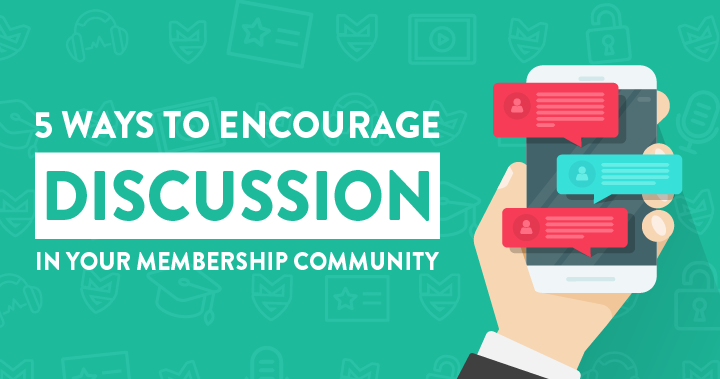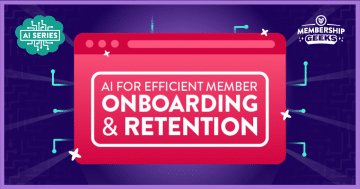Is your membership community a ghost town?
Are you constantly banging your head against a wall trying to figure out ways to get your members to actually converse with each other?
It's been said many times before – people come for the content but they stay for the community.
However, getting an active, thriving community inside your membership is easier said than done.
It’s not a case of just setting up a forum or Facebook group and assuming that conversations will start flowing, and connections will happen automatically.
You need to put in the work to drive the discussion and the connections within your own community.
It can take quite a bit of time to get the discussion flowing, particularly in the early days where this can feel like trying to push a boulder up a hill.
But these steps will help to get it done:
1. Start The Discussion Yourself
First things first, you need to accept that in the early days all the work falls on your shoulders.
You’re going to have to be the one who drives the conversation.
It’s not going to be a case of just creating a forum or a Slack channel, giving people the link, and seeing the engagements and discussions happen.
Whether your community is new or whether it’s been running for a while but has become something of a ghost town, the onus is on you to drive the initial conversations that will gain momentum.
It’s a lot easier for people to reply to a conversation than it is to start one.
If you’re the one starting discussions, you’re a lot more likely to see replies and contributions from people who are on the periphery of the group and who are not likely to start a conversation themselves.
Once they get comfortable joining in with talking points and adding their thoughts and opinions, they’re a lot more likely to start a discussion of their own.
Our online forum for the Membership Academy has thousands of members and is very active, but we still make a point of driving discussions ourselves.
Every week we choose a hot-button topic to start a discussion of the week.
We make it a regular part of our role as community heads to kick-start these conversations.
We often find that for some people, taking part in these discussions of the week will be the first time they’ve contributed anything to the forum.
Then, once they’ve spoken up and made their voice heard, we start to hear from them on a regular basis.
You need to lead by example.
Once you take that action, put the work in and start the conversations, momentum will take over and in time not all the work will rest on your shoulders.
2. Encourage “Low-Hanging Fruit” Conversations
If you’ve got a group that is all about something like managing your money or financial discipline, that’s a serious topic about a serious aspect of people’s lives.
That might be a daunting discussion for the average community member to kick off themselves, or even to contribute to.
Especially if someone is new to the group or hasn’t spoken up yet.
If all the conversations are a serious, heavy topic, that person might feel timid about putting their head above the parapet and voicing their opinion.
A lot of people in your community will have no problem joining in any and every conversation.
But some people need time to warm up and grow comfortable first, particularly if they’re a little more introverted or less familiar with online conversations.
Think about your members who are not as experienced as everyone else.
They might be sitting back thinking that their opinions hold less value, being self-conscious about contributing.
This is where “low-hanging fruit” discussions can really help people to build their confidence and comfort level in the group.
What we mean by “low-hanging fruit conversations” are things like:
- “How was your weekend?”
- “What do you think of the new series of Game Of Thrones?”
- “What’s the view out of your window right now?”
That kind of off-topic, light, low-level discussion might seem like it doesn’t have value in a group where everyone is talking about serious topics.
But trust us, the power of those kinds of conversations is to give people an easy way to start being an active part of your community.
The discussions ease people into participating and making their voice heard, rather than sitting back and watching what everyone else is talking about.
The value of “low-hanging fruit” discussions is immense because it’s so much easier to weigh-in with your opinion on “Marvel Vs DC” or “are we living in The Matrix?” than it is to chime in with your thoughts on a more serious conversation.
There’s no divisiveness, no deep-thinking, no scary aspects to those types of questions.
You’re going to get a ton of responses to that, and no, it’s not high-value conversation, but once someone has got used to joining in with discussions like that, they’re more likely to dive into the substantial stuff.
3. Don’t Rush To Answer Every Question Yourself
Most online membership groups are started by experts.
People who have knowledge, experiences, skills, and expertise that they leverage into training material as well as advice and support in a community.
And a lot of time one of the driving factors behind someone joining your community is that they get to ask you questions.
Obviously, that is a valuable aspect of your membership, but what it can lead to is the head of the community feeling like they have to answer every question.
The problem with that approach is that it shuts out other voices in your community who may have valuable contributions to make.
People have joined your membership group because they’ve seen your experience and skills in practice, and they trust your knowledge.
So, when they see a response from you, that is the be-all-and-end-all of the discussion.
They will consider your response to be the bottom line.
Even if you didn’t intend for your response to be the definitive position on the question, it will be viewed that way.
Which, in turn, makes them much less likely to pay attention to any other responses from the rest of the community.
This will also put off other community members from joining in with their thoughts and opinions.
Even if someone in the group has personal experience of this topic and a great insight to share, they’ll see the community leader has given a response and can be completely put off.
What’s the point of joining in when the question has already been answered?
My voice isn’t needed, the discussion has been closed.

Are you sending this message to your community?
If you’re getting to every question first and answering straight away, you’re shutting down discussions before they get a chance to start.
So, it can be worth strategically stalling.
Even if you see a question being asked and no one has answered it yet, it is worth stalling your response until later in the day or even the next day.
Give the question some breathing room and let your other members come in and respond and start a discussion.
We see seasoned membership owners complaining “My members never talk to each other! It’s always me who has to answer everything!”
And these same owners are answering every question within an hour of them being posted!
Their members aren’t responding because they don’t feel like they need to.
The opportunities for discussion are being shut down.
Don’t go crazy and leave questions unanswered for weeks but give things a chance to breathe and let your other community members share their valuable experiences and insights with each other.
4. Tag Other Members In Discussion
Don’t assume you’re the only person who can respond to questions.
A great way to get other members to participate and be more active is to pull them into the conversation yourself.
When a question is posed in the group, even if you know the answer you might also know three or four people who are better suited than you to provide insight.
Rather than answering the question yourself, or coming in to say “I know this happened to John and this is what he did and these were the results” tag John in the response and say “I know this happened to John and I know that he handled it really well so I’m going to ask him to share his experience with you”.
It might be tagging one person with specific experience, or you might tag a whole bunch of people who are all in a certain industry, a certain age bracket, or a certain demographic that matches up with the question.
For us inside the Membership Academy, we might get a question that says “has anyone here had any success using webinars for memberships?”.
We know a whole bunch of members who have posted before about getting great results from webinars, so we tag them all in the discussion.
Once you’ve tagged the relevant people and invited them to share their knowledge – you need to exit the discussion.
Embrace the role of not just the expert who answers questions, but as the community leader.
Embrace being the person who creates connections between your members and facilitates the best path of learning.
Sometimes the best path of learning doesn’t run through you, but it needs you to pull in the members of your community who have value to add to the conversations.
Making a concerted effort to pull members into a conversation and have them answer questions instead of you, is a great way to encourage further discussion in your membership.
You’re making those people feel valued and important, and it gives them a little nudge to come into the group, be active and engage.
5. Include Your Community As Part Of New Member Onboarding
The best way to encourage people to be active in your community is to get them in there early and ensure your community is an integral part of the member experience.
When someone first joins your membership, they’re going to be really excited and raring to go, so that’s the perfect time to get them into your community and to start building the habit of contributing.
You want to immediately reinforce that the community is a key part of what they’re paying for, a key part of what’s going to help them achieve their goals.
Make it as simple as possible for new members to take that first step.
Have your member onboarding process include a step that drives new members to come into the community and introduce themselves.
If you’re using a forum, you can have a specific section for new member introductions.
Make sure your onboarding links to that section of the community and gives some pointers on how to introduce themselves.
Highlight why they really want to make sure they’re taking part and engaging in the community.
So, if your membership community is struggling to get started, or if it’s been running for a while but is starting to look a bit like a ghost town, implement the our tips to help stimulate discussion and engagement.





